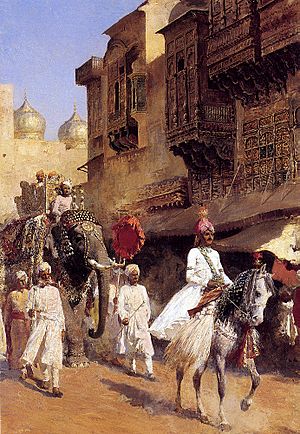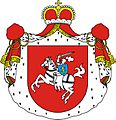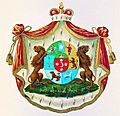Prince facts for kids
- This article is about the royal title. For the musician, see Prince (artist). For other uses, see Prince (disambiguation).
A prince is usually a male member of a royal family. The word "prince" comes from the Latin word princeps, meaning "chief" or "first". A prince is often the son or grandson of a king or queen. The female version of a prince is a princess.
In many countries, princes are born into their roles. They are part of the family that rules a country. Sometimes, a prince might even be the next in line to become king. This is called being the heir apparent. In some small countries, like Monaco and Liechtenstein, the ruler of the country is actually called the prince, not a king.
Contents
What is a Prince?
A prince holds a special title within a royal family. This title shows their rank and connection to the ruler. Princes often have important duties. These can include representing their country or helping with charity work.
Different Kinds of Princes
The meaning of "prince" can change from one country to another.
- Heir to the Throne: The most common type of prince is the son of a king or queen. He is often expected to become the next ruler. For example, in the United Kingdom, the eldest son of the monarch is usually given the title Prince of Wales.
- Royal Family Member: Other sons, grandsons, or even nephews of a monarch can also be called princes. They are part of the royal family but might not be in line to become king.
- Ruling Prince: In some countries, the leader himself is called a prince. This is true for the Prince of Monaco and the Prince of Liechtenstein. They are the heads of state for their nations.
- Noble Title: Historically, "prince" could also be a high noble title in some parts of Europe. These princes might not have been part of a ruling royal family. Instead, they were powerful landowners or leaders of important families.
Princes in History
Princes have played many roles throughout history. They were often involved in politics and wars.
- Ancient Rome: In ancient Rome, the term princeps was used for the leading citizen. It was a title for the first emperor, Augustus, who wanted to seem like a regular citizen, not a king.
- Medieval Europe: During the Middle Ages, princes often ruled smaller areas called principalities. These were like small kingdoms. They had their own armies and laws.
- Renaissance and Beyond: As countries grew, princes continued to be important. They often married into other royal families. This helped to create alliances between nations. Many famous historical figures were princes, like Prince Henry the Navigator who explored the seas.
Modern Princes
Today, many countries still have princes. Their roles have changed quite a bit.
- Symbolic Roles: In countries like the United Kingdom, Japan, or Sweden, princes often have mostly symbolic roles. They attend public events, support charities, and represent their country.
- Active Rulers: In places like Monaco and Liechtenstein, the prince is still the active head of state. They have real political power and lead their governments.
- Education and Public Life: Modern princes often go to universities and serve in the military. They are prepared for public life from a young age. Many use their position to raise awareness for important causes.
Princes are an interesting part of history and modern society. They show how traditions can continue even as the world changes.
Images for kids
-
Cicero attacks Catiline in the Senate of the Roman Republic.
-
Louis de Bourbon, Prince de Condé, was the premier prince du sang during his lifetime (painted by Joost van Egmont).
-
José, Prince of Brazil, Duke of Braganza, died before he could ascend to the throne of Portugal.
-
Coat of arms of the princes Sanguszko-Lubartowicz (Poland).
-
Თავადი ყანწით (მელიტონ ჩხეიძის პორტრეტი). ნიკო ფიროსმანი. 1906.jpg
Georgian prince, Tavadi.
-
Saint Robert Cardinal Bellarmine was a prince of the Roman Catholic Church during his lifetime.
See also
 In Spanish: Príncipe para niños
In Spanish: Príncipe para niños








